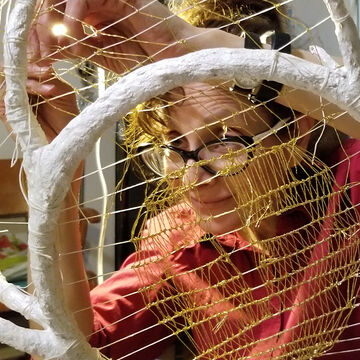

Mindy Rose Schwartz
Assistant Professor, Adjunct
Contact
Bio
Instructor, Sculpture (2003). Education: BFA 1985, University of Illinois at Urbana; MFA, 1996, University of Illinois at Chicago; Teaching Certification, SAIC 1992.
Exhibitions: Interstate Projects, NY; Tatjana Pieters, Ghent, Belgium; awhrhwar LA; Room E-10 27 at Center, Berlin; Belice Hertling, Paris; Eric Hussenot, Paris; Saint Cirq la Popie Bienniel, Saint-Cirq Lapopie, FR; Arcadia Missa, London; Carlos Ishikawa Gallery, London; QT Gallery, NY; Atlanta Contemporary, Atlanta, GA; Et al. Gallery SF, CA; Cooper Cole, Toronto; Alter Space, LA; Los Angeles Contemporary; Prairie Gallery, Chicago; Slow Gallery, Chicago; Terrain Gallery, Chicago; Renaissance Society, University of Chicago; Spertus Museum Chicago; and Rose Art Museum, Waltham, MA. Bibliography: Art in America, Art News, Art Forum, Art Space, Art Viewer, Contemporary Art Daily, Dream the End, New City, The Seen, AJS Perspectives, New American Painters, Frieze, New Art Examiner, Dialogue, Chicago Reader, WBEZ, Bad at Sports, Whitewalls, Beautiful Decay. Publications: Trigg, Sarah, Studio Life: Rituals, Collections, Tools, and Observations on the Artistic Process, Princeton Architectural Press 12/17/13, Harvard Design Magazine No. 45, Ed. Sigler, Jennifer, Into the Woods, p. 150, 2018 Awards: Helen Coburn Meier and Tim Meier Foundation for the Arts, 3Arts Residence Fellowship, Frankel Foundation Residency Fellowship; Visiting Artist, Illinois State University; CAAP grant.
Mindy Rose Schwartz is an artist living in Chicago. She uses a wide range of materials and processes with specific cultural references, and often undervalued cultural status, to frame them in a different light. Her sculptures demonstrate the ways in which the intended significance or function of mass-produced objects can oscillate in our perception, being sites of fear or control, as well as sentiment, longing and pleasure.